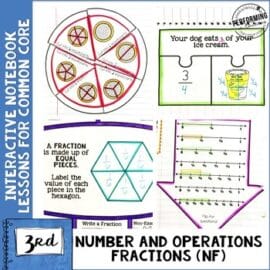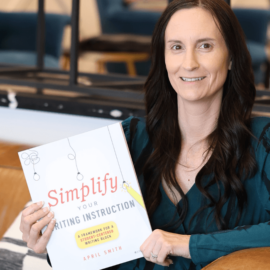Let’s face it, none of us became teachers thinking we’d be where we are today—buckled up on a virtual learning rollercoaster. Education is changing quickly, and our classrooms look very different than they did last Spring—and still different from how they looked last fall. Whether you’re teaching in person, remotely, or in a hybrid classroom setting, you might be feeling overwhelmed by the sudden push to adapt traditional resources to suit a whole new style of teaching and learning.
Maybe you’re like me—a tech-savvy millennial who’s been onboard with the e-learning revolution for quite some time—and yet, you’re struggling to find a “sweet spot” to cater to both in-person and virtual learners in your hybrid classroom.
Or maybe you’re a time-honored teacher—the one us millennials go to for advice—prepared with binders of resources divided by subject and unit, with extension activities, crafts, and exemplars all pressed neatly in sheet protectors and organized by color-coded divider tabs. If this is you, you might be feeling that these resources are falling short when it comes to engaging your distance learners and crafting interactive virtual lessons.
To my teachers everywhere, regardless of how you teach or how long you’ve been teaching—the time has come to reimagine our classrooms and hop onboard with the newest new normal. And though it might seem like a huge feat, you are not alone! We‘re here to help as we, too, discover new ways of teaching that effectively engage all learners in our classrooms. That’s why we’ve compiled a list of virtual learning resources to help you re-envision your new—“digitally remixed”—classroom.
Get Visual with a Virtual Whiteboard
You probably have a good stock of anchor charts that have not seen the light of day since before the onset of distance learning in March. If you’re like me, you might‘ve hung them haphazardly in a closet in your classroom, rolled them up and stuffed them in your trunk, or hidden them from your significant other in the garage.

While I will bet that these anchor charts are worth their weight in gold, you might have noticed that they do not engage your virtual learners as much as you hoped they would. And that’s okay. Let’s hope we can take them out next year! There are countless ways to make visuals more interactive to support distance learners. While there‘s a long list of resources and apps out there, here are a few of our favorites:
Desmos is a great free website that offers a collaborative whiteboard with real-time feedback. Students enter a join code and complete challenges using digital math tools. Desmos also offers an extensive library of ready-made math activities for teacher use.
The Zoom Whiteboard feature is a go-to when it comes to live instruction, pre-recorded videos, and individual teaching or tutoring. This feature allows both teacher and student to interact with the content and is perfect for modeling, shared writing, or collaborative problem-solving. Interested in learning how to use Zoom to record mini lessons? Checkout our tutorial Distance Learning: Using Zoom to Record Writing Lessons.
Canva is an incredible app that teachers can use to create a variety of classroom resources for distance learning, including anchor charts, video tutorials, and book trailers. Check out their free teacher account, which allows access to premium features, including an extensive image library!
Help Virtual Learners Stay Organized with Virtual Folders
If students’ desks aren’t already messy enough, add virtual resources to the mix and finding resources and homework can become a serious challenge. To remedy this dilemma, try Bublup or Google Drive.
Create a Shared Virtual Turn-In Bin on Bublup
Bublup has a free limited account and is great for organizing resource folders and creating virtual turn-in bins. Teachers receive notifications when students drop assignments into a Bublup folder—so no more searching for assignments in your black hole of an email inbox. We love Bublup because it is visually appealing, making it easy to locate the folder you’re searching for in a flash. Want to learn more about how to use Bublup in your classroom? Check out this how-to guide for teachers.
Color-Code your Folders on Google Drive
Google Drive is a popular platform for saving and sharing digital resources, which makes it a good tool for the digital classroom. But — have you ever tried searching your Drive for a worksheet you created a few years back, and after spending way too much time searching every title and keyword that comes to mind, still no luck? Well, I certainly have. One feature that helps me keep track of important items in my drive is color-coding my folders—not as visually appealing as Bublup, but a definite life-saver when you’re in a time crunch.

Simplify Virtual Learning with Interactive Notebooks

When I began teaching, interactive notebooks consisted of flipbooks and foldables that teachers would distribute to students at the beginning of a new lesson or unit; students would glue these interactive into their journals to refer back to when reviewing or studying in the future. Though these interactive journals are still just as relevant and resourceful, this is not the kind of interactive notebook I’m referring to. I’m talking about the (drum-roll, please!)….digital kind.

Goodbye spiral notebooks! Using Google Slides or PowerPoint, these new interactive notebooks are the perfect digital upgrade for virtual learners. Using their devices, students can take notes directly on the Slides as their teacher models new concepts during mini-lessons. Students can jot down important information or provide explanations in text-boxes. They can drag and drop correct answers to multiple choice challenge questions, use preloaded icons to chart number lines, fill out dates and events on timelines, and so much more! Check out this tutorial explaining how teachers and students utilize interactive notebooks to simplify virtual learning.

Ready to give these interactive notebooks a whirl in your classroom? Head over to our TPT store to explore the virtual learning resources that we’ve created for use in the reimagined digital math classroom!
What resources are you using in your hybrid and virtual classrooms? Share them with us in the comments below!


